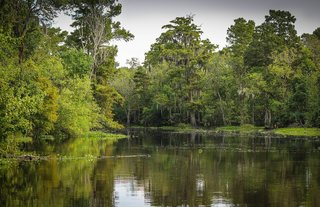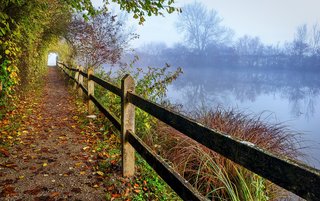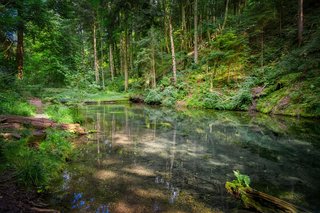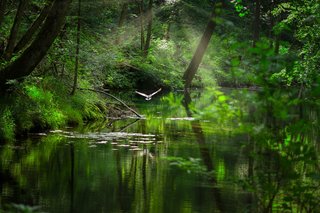For someone who just began in bowfishing, the desire to know may feel overwhelming because you have so much to learn. You want to know about everything in the sport that you need to get started. Don’t worry. We’re going to cover absolutely everything that you need to know and more. This straightshooting guide will get right to the point to leave you smarter and more informed about the sport of bowfishing.

Definition of Bowfishing
Bowfishing happens when bowfishermen have a bow and they shoot the fish with an arrow. The arrow will have a string attached to it so that you can reel in the fish after you have shot it.
You might call this sport as closer to hunting than what you would with fishing. Typically, you will do this with non-game fish species like common carp, Asian carp, grass carp, bighead carp and silver carp. In fact, it is illegal to bowfish game fish species, such as:
- Sturgeon
- Trout
- Walleye
- Bass
- Redfin
- Northern pike
- Sauger
- Sunfish
You can’t bowfish any of these fish species. In some areas like southern Alaska, you can bowfish for northern pike because they’re an invasive species to this area. You also have some regions of Colorado where you can bowfish for northern pike, but you should always check with your local DNR.
What Fish Species Can You Bowfish?
Some of the fish species that you can bowfish, include:
- Alligator gar
- Catfish
- Gar
- Buffalo
- Common carp
- Silver carp
- Bighead carp
- Freshwater drum
- Paddlefish
- Suckers
- Grass carp
- Bowfin
These are some of the fish that you can actively bowfish for. What you can bowfish for will also depend on your state and region. You should first check with your local DNR. They can give you the specifics of how to go bowfishing.

How You Shoot in Bowfishing
Unlike with traditional archery, bowfishing arrows don’t have fletching on them. This helps them to penetrate the water better. Along with no feathers, they weigh more than traditional arrows. Bowfishing arrows weigh 650 grains, while traditional arrows only weigh 285 grains. That should put things into context. This helps the arrows to shoot deeper into the water.
With bowfishing, you won’t normally shoot in water deeper than 5 feet. Ideally, the water will be between 3 feet and 5 feet. The arrows penetrate the water better in water this shallow. Along with the shallowness of the water, the shots taken happen from between 10 yards to 20 yards at most.
You also aim about 6 inches below the fish to account for light refraction, but it depends on the depth of the fish. Typically, the deeper the fish, the lower you will aim. Light refraction bends the wave of light to create an illusion of where the fish actually sits. You will want to account for this when you take shots.
In all honesty, your first 30 to 40 shots won’t connect with much. You have to practice a lot, but once you get used to it, it becomes much like regular archery shooting, only you aim lower.
Where to Go Bowfishing
Before you go bowfishing anywhere, I would first advise that you speak with your local DNR. You can’t just bowfish anywhere, but bowfishing is legal in every state. No matter where you reside, you can most likely go bowfishing somewhere in your state. Be aware, however, not all lakes and rivers in the state are legal even if you can find somewhere that it is legal.
Some of the most popular places for bowfishing include:
- Texas
- Louisiana
- Ohio
- Indiana
- Florida
Whether its lakes, rivers, streams or reservoirs, you can bowfish in a variety of places. Some of the popular mentions of the best places to go bowfishing include the Missouri, the Mississippi, Trinity River and the Gulf Coast of Louisiana are all popular places to go bowfishing.
Also, you can go bowfishing in saltwater for different things like:
- Sting rays
- Flounder
- Sharks
- Sheepshead

Like always you should contact your local DNR to know the exact regulations. It can differ from one lake to the next, so you must first make sure that you can do it legally at the lake or river that you want to do it.
Boat vs Shore
In most cases, I’d recommend that you do bowfishing from a boat. That isn’t to say that you can’t go bowfishing from shore, but you will typically find bowfishing from the boat more productive. In general, they will do bowfishing from a flat boat called a jon boat (you can also do a pontoon)because it stabilizes the boat.
When you take your shots, you don’t have to worry that the boat will unsteady your aim as much. They also do this from a raised platform usually, but you don’t have to bowfish from a platform in the boat. It does make taking shots easier.
On the other hand, you have bowfishing from shore. The biggest advantage of this comes from the lower entrance barrier. You don’t have to pay quite as much to get started bowfishing. The most expensive thing about bowfishing will usually be your boat.
After that, it’s the lights and generator that cost the most. All of this is equipment for the boat. If you cut these things out, it costs much less to go bowfishing. You just need a bow and arrows and a reel, and you can get started. That said, I still prefer bowfishing from a boat. You can access more of the river, and if you dislike one area, you can flip on the motor and head to another one easily.
I might recommend that you start bowfishing from shore, but you will want to make the upgrade at some point. You don’t necessarily have to bowfish from a jon boat.
You could also bowfish from a kayak like the Perception Pescador Pilot 12. This kayak allows you the superior standing position to take your bowfishing shots. That matters because I’ve never known anyone who could take the shots from the sitting position.
The other great advantage of going with the Perception brand is that the company stands behind their products. If you experience problems of any kind, they will back you up.
Bowfishing: The Gear You Need
You have a few things that you need in bowfishing, and you have some other stuff that is nice-to-have kind of things. You can make bowfishing as expensive or as cheap as you want to make it.
Some of the stuff that you should have when bowfishing include:
- Bow
- Special bowfishing arrows
- Boat
- Camouflaged clothing
- Reel
- Bowfishing lights
- Generator for the lights
- Cooler and storage box
Reels
When it comes to the reels in bowfishing, you have a couple of different types:
- Bottle reels
- Spincast reels
- Hand reels
Bottle reels most likely ranks as the most popular type of reel that you will encounter. I prefer bottle reels myself because of how you can depend on them. You have one part of the bottle, which houses the line, and on the other side, you have a handling that is like a fishing reel.
Next, you have spincast reels. This works like a regular spincast reel, and if you’d like to learn more about that, check out my article, “What is a Spinning Reel?“
Finally, you have hand reels. Perhaps the simplest of the three reels available to you, a lot of people call this the reliable method, and when all else fails, many bowfishermen fall back on the hand reel. This equates to a spool with a line wrapped around it. After taking the shot, you just grab the line and wrap it around the drum.
If I were to choose the hand reel, I’d do it because of its simplicity, and you don’t have to worry that anything will break. This does require a heavier line, but that also means that you have a stronger line when you go to take your shots. This type of reel does require a lot of manual work, which is probably part of the reason that it has fallen out of favor and lost to the bottle reel.
Arrow Safety Slides
Before you ever take your bow and arrow to the water, please, do yourself a favor and buy an arrow safety slide. The AMS Bowfishing 5/16 inch EverGlide Safety Slide is a popular choice that has proven its worth.
Why do you want arrow safety slides? You want this because when you go to take a shot, you don’t want the line attached to the arrow tangling with the bowstring. This can send the arrow shooting back in your direction. People have not only suffered injuries, but they have been killed because they refused to buy a safety slide.
This gives the entire sport a poor reputation, when much of the danger could’ve been avoided if they had only taken the right precautions. Especially if you’re a beginner to bowfishing, this can make a world of difference. I won’t even fish without one, and I won’t take anyone out on the water who won’t fish without one. It’s unsafe.
Arrow Tips
Depending on the type of fish that you target, you may need more serious arrow tips. For example, if you target gar, they have armor for skin, and you can’t pierce their skin as easily as carp or buffalo.
The Muzzy Bowfishing 1010 Quick Release Gar Point Fishing Point for Tough Skinned Fish works especially well for that purpose. In addition, it ensures that if you hit the gar, you don’t miss because the arrow failed to take hold.
In general, you’d be wise to keep your sharpest arrow tips on hand because they will pierce better. To keep your arrow tips sharp, avoid hitting rocks or anything that could dull the tip. Look at the bottom of the water to see the places where you will take the shot. In some cases, you can’t avoid it. I’d rather take the shot and risk dulling the tip, rather than not take the shot at all, unless I’m running low on bowfishing arrows.
Know Your Fish
You will increase your chances of success if you know the fish that you hunt. For example, you will find it useful to know where they like to hide so that you can target their hiding places.
Let’s take the catfish as an example. If you want to bowfish catfish, you should look for them in a rocky or a sandy riverbed. Especially in places where the current runs at a more tranquil pace, you will find you have more success. Many fish hide in places like this where they might seek their next meal.
For carp, they like to hide in areas where they can feed like with insects or larvae. Look for dense vegetation or muddy waters because carp tend to stir up the waters.
Bottom line here is that whatever fish you want to go after, you should know a little about your fish because this can help you to bring home more of them. You will have more chances to put an arrow through them.
The Biggest Fish That You Can Bowfish
If you want to know the biggest species of fish that you can bowfish, it’s most likely the catfish. The biggest catfish that they ever caught weighed 646 pounds. As for the second largest fish that you can bowfish, it’s the alligator gar at 327 pounds. You should first check your local regulations before you go after any type of fish to make sure that you can legally shoot them.
Here’s a helpful list of some of the biggest bowfishing species fish that have ever been caught:
- Bowfin – 21 pounds.
- Suckerfish – 37 pounds.
- Buffalo – 54 pounds.
- Freshwater Drum – 60 pounds.
- Bighead Carp – 61.7 pounds.
- Grass Carp – 93.3 pounds.
- Silver Carp – 100 pounds.
- Common Carp – 108 pounds.
- Paddlefish – 198 pounds.
- Gar – 279 pounds.
- Alligator Gar – 327 pounds.
- Catfish – 646 pounds.
These are the non-game species available for bowfishing and the biggest sizes that they caught. I find it easiest to target carp because of their prevalence in US waters, and I go after the other fish as a side quest when they pop up.

How Much Draw Weight Do You Need for Bowfishing?
Most experienced bowfisherman recommend that you use a draw weight of between 40 to 50 pounds. I wouldn’t say to go any lower than 40 pounds because you don’t want to miss your shots.
That said, you don’t want to go much higher than 50 pounds because you don’t want the arrow to plow straight through the fish and into the nearest underwater log. This can be a crazy situation that is better to avoid. For that reason, anything between 40 to 50 pounds is most agreeable.
You should also be aware of how some states have regulations on the draw weight for bowfishermen. California, for example, requires that you have a draw weight of 40 pounds or higher. If a minimum draw weight exists, you will need to check with your local and state regulations.
Converting a Bow to a Bowfishing Bow
The best part about bowfishing comes from the versatility of the sport. It doesn’t require much. If you’ve already got a bow, you just need some heavy bowfishing arrows and a reel.
I would recommend that you have a bow set up especially for bowfishing. Don’t make it your best whitetail bow. The problem with this comes from how you bang around a lot in the boat, and your bow takes a big beating from this. Your best bow will become a shadow of its former glory.
The Cajun Fish Stick Take-Down Bowfishing Bow Set is a good budget bow that you use while out on the water. They packaged this with everything that you need to start bowfishing, so especially if you’re a bowfishing beginner, you may find this useful.
Why would I say to choose a bow specifically tailored for bowfishing? These bows have little to no let-off. That means that you can take snap shots without having to bring your bow to a full draw.
In bowfishing, you will rarely come to a full draw because you have to respond quick, and bowfishing bows were also designed so that they are waterproof and rust proof for long-term durability. With a regular hunting bow, you may not get this.
Sights on a Bowfishing Bow
It’s not that you couldn’t use the sights on a bowfishing bow, but you will rarely have time to use it. In most cases, you will be taking quick shots, and you won’t aim with the sight. Bowfishing is a fast-paced sport that differs much from hunting. In fact, it’s neither like hunting, nor is it exactly like fishing. Bowfishing is a sport unique unto itself. You will find nothing else like it.
Rubber Finger Savers
Many times, people overlook rubber finger savers. I wouldn’t make that mistake. You put it on your bowstring, and they will save your fingers. Especially because you can take up to 50 to 70 shots in a single night, you’d be surprised what a value they can prove.
The YLS Archery Bowstring Finger Savers Finger Guards work great for this purpose. Instead of rubber finger savers, you could also choose to wear a glove, which works just as well.
What to Do with Dead Carp?
With some fish like gar, they taste delicious, so you’d most likely fry them up in a pan and get to eating some tasty fish. That said, not everyone likes the flavor of carp. You can shoot as many carp as you’d like, but you may feel at a loss for what you can do with this fish because you dislike it.
Don’t simply throw it off on the shoreline. Not only is this illegal in some places for good reason, but it is poor sportsmanship. Here are four of the best things that you can do with dead carp:
- Give it away to someone who likes carp.
- Smoke the carp and eat it.
- Cook the carp the traditional way.
- Compost the dead carp.
Believe it or not, you can get some powerful fertilizer out of dead carp. The one thing that you should understand, however, is that you don’t want to bury the carp in your garden. I’ve seen this advice before, and it is terrible advice. You don’t want to put organic matter that hasn’t fully composted straight on your garden.
That will go into your plants, and it won’t be healthy for you. These fish are scavengers, and they eat a lot of bad stuff from the bottom of the lakes and rivers. For that reason, some people consider them a dirty trash fish because they can be extremely polluted as a fish.
Instead of composting them in this way, you will first let the carp sundry. You dry it out as much as possible because this lowers the smell of decaying carp meat. After you have done this, you mix the carp in with the compost pile while grinding it up. Doing it in this way kills off the dangerous bacteria that can get into your plants. Once you have composted the carp, you put it back into the soil to enrich it as an excellent source of nutrients.
The Best Lights for Bowfishing
As a bowfisherman, you may find yourself wondering about the types of lights that you would use for bowfishing. First, you have to look at the bulbs that you want to use. High pressure sodium lights are probably the most common, and they don’t cost as much as some of the other choices.
Meanwhile, they penetrate the water well, and these bulbs will last a long time. Many bowfishermen prefer this form of lighting, but you do have some other lights in bowfishing, such as:
- Halogen
- LEDs
- High Pressure Sodium (HPS for short)
With all forms of bowfishing lights, you will need a generator. The DuroStar DS1050 is one choice that costs less than many of the other choices, and it comes with an effective run time of six hours. This may not be the best choice out there, but if cost is a barrier, this might be a good entry point.

Can You Use LED Light Bars for Bowfishing?
I know of people who can and have used LED light bars for bowfishing. In particular, these work well for when bowfishing on clear water. This depends on where you live. For example, most rivers and lakes in Texas tend to be somewhat muddy where HPS lights will be the best kind of lights for bowfishing.
Depending on the setup, you can get them so that they wil work well in both clear and murky water.
Bowfishing is a sport that takes time to learn. Hopefully this bowfishing guide has helped to shed some light on the subject. The most important thing that you can do to get started is to get the bow and arrow and the necessary equipment. You don’t necessarily need a boat, but if you get more into bowfishing, you will want to have a boat because it gives you access to some of the best bowfishing sports. Myself, I’d much prefer to bowfish from a boat, but if you don’t have one, you could speak with a buddy who does have one and who likes to bowfish. The more, the merrier.
